
When exploring HVAC systems, you’ll often come across the term BTU, but what does it really mean? Understanding BTUs is key to making informed decisions about heating, cooling, and overall energy efficiency in your home. In this post, we’ll break down the meaning of BTU, what it measures, and how it applies to furnaces and air conditioners. We’ll also discuss the importance of proper HVAC maintenance in ensuring optimal BTU performance. Whether you’re upgrading your system or simply curious, this guide will help you understand why BTUs matter.
- BTU Meaning Explained
- Difference Between Furnace BTUs and AC BTUs
- Energy Efficiency Ratings and BTUs
- How Proper HVAC Maintenance Affects BTUs
You can contact Service 1st whenever you need professional HVAC maintenance, repairs, or installations you can trust.
BTU Meaning
1. BTU Meaning Explained
If you have no heat, here are some basic furnace troubleshooting steps you can take.
When shopping for a new furnace or HVAC system, you may hear a lot about BTUs. But what does that mean, and why is it important for your home?
BTU stands for British Thermal Unit, which is a measure of energy. In simple terms, one BTU is the amount of energy needed to heat or cool one pound of water by one degree Fahrenheit. While the term might sound technical, think of it as a way to measure how much heating or cooling power a system can deliver.
For furnaces, BTUs indicate how much heat the system can provide to your home in one hour. For example, if a furnace is rated at 80,000 BTUs, it can generate 80,000 units of heat per hour. The higher the BTU rating, the more heating power the furnace has.
Bigger Isn’t Always Better!
Choosing a furnace with the right BTU rating for your home is crucial. A furnace with too many BTUs may heat your home too quickly, causing it to turn on and off frequently, which wastes energy and can lead to uneven temperatures. On the other hand, a furnace with too few BTUs may struggle to keep your home warm, especially on colder days.
These systems are designed to regulate indoor temperature, humidity, and air quality, ensuring comfort and safety for you and your family.
How to Calculate the Right BTU Rating for Your Home
To determine the right BTU rating for your furnace, a heat load calculation is performed. This process considers several factors about your home to estimate how much heating it requires. Here’s an overview of how it works:
Measure Your Home’s Square Footage
Start by calculating the total square footage of the area you need to heat. For multi-story homes, include all levels.
Factor in Your Climate Zone
Your location plays a big role in how much heating your home needs. For example:
- Homes in warmer climates (Zone 1) need about 30-35 BTUs per square foot.
- Homes in colder climates (Zone 6 or 7) may need 50-60 BTUs per square foot.
Consider Insulation and Construction
A well-insulated home with energy-efficient windows and doors requires fewer BTUs. Older homes or those with minimal insulation may need higher BTUs to compensate for heat loss.
Account for Ceiling Height
Higher ceilings mean more air volume to heat. If your ceilings are above the standard 8 feet, you’ll need additional BTUs to maintain comfort.
Take Into Account Other Heat Sources
If your home benefits from passive heating sources, like large south-facing windows or a fireplace, you may require fewer BTUs. Conversely, homes with lots of drafty areas or minimal sunlight may need more.
BTU Meaning: A professional HVAC technician can accurately calculate the right BTU rating for your home.
A professional HVAC technician uses specialized software to perform this calculation accurately, ensuring every variable is considered. While you can estimate BTUs on your own, working with a professional ensures you get the most precise results for maximum comfort and efficiency.
In summary, BTUs are a simple way to understand how much heating power a furnace provides. By performing a proper heat load calculation, you can ensure your furnace is perfectly sized for your home, keeping you warm and your energy costs in check.
2. Difference Between Furnace BTUs and AC BTUs
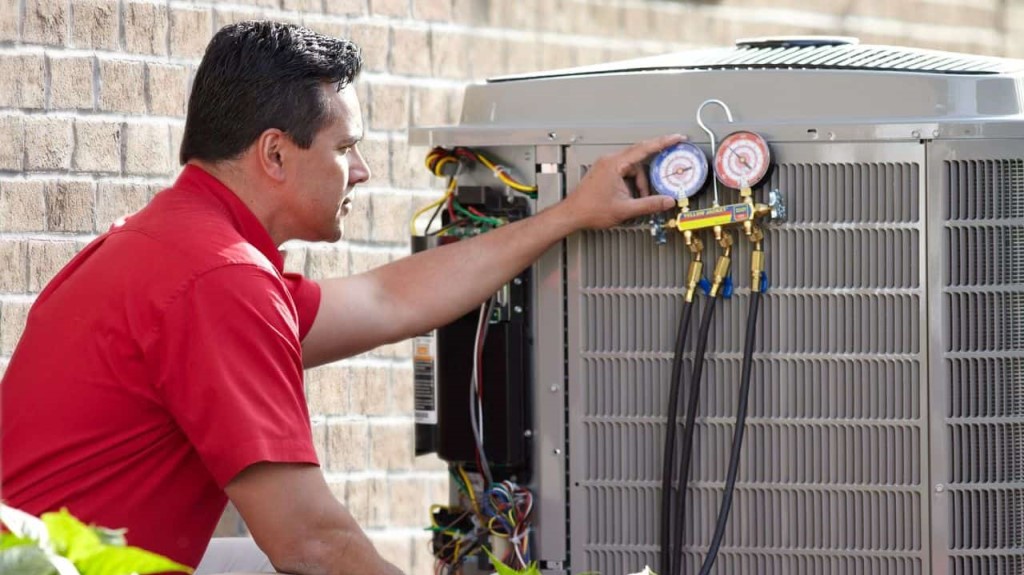
BTU meaning for Air Conditioners: They measure your unit’s cooling capacity.
BTUs are used to measure the energy capacity of both furnaces and air conditioners, but how they apply to each system is different. Understanding this difference is essential when choosing the right equipment for your home.
Furnace BTUs: Heating Power
Furnace BTUs measure the amount of heat the unit can produce in one hour.
For instance, a furnace rated at 60,000 BTUs generates 60,000 units of heat per hour, making it a suitable choice for smaller homes or spaces. The size of the furnace you need depends on factors like your home’s square footage, insulation, and climate.
Furnaces typically have higher BTU ratings because they are designed to warm up an entire home quickly and efficiently during cold weather.
AC BTUs: Cooling Capacity
For air conditioners, BTUs measure the unit’s cooling capacity, specifically how much heat the system can remove from your home in one hour. Unlike furnaces, which add heat to your home, air conditioners work to lower the indoor temperature by pulling warm air out and circulating cool air back in.
The cooling capacity of air conditioners is often described in “tons,” where one ton equals 12,000 BTUs. For example:
- A 1.5-ton AC has a cooling capacity of 18,000 BTUs.
- A 3-ton AC has a cooling capacity of 36,000 BTUs.
How to Choose the Right AC BTU Rating for Your Home
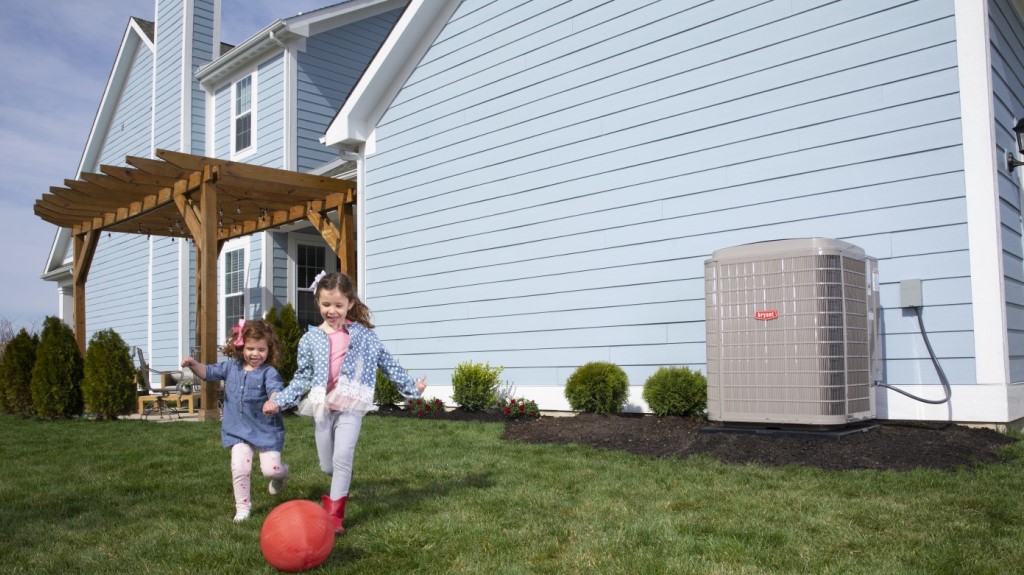
BTU Meaning: If you live in a warmer climate you will require more BTUs than if you live in a cooler climate.
Choosing the correct BTU rating for your air conditioner is critical for maintaining comfort and efficiency. Here’s what to consider:
Home Size and Layout
Larger homes or open-concept designs require higher BTU ratings to cool the entire space effectively. Smaller homes or single rooms may need a lower BTU rating to avoid overcooling, which can waste energy and increase costs.
Climate and Sun Exposure
Homes in hotter climates or with significant sun exposure (e.g., large windows or west-facing walls) may require a higher BTU rating. Shaded homes or those in cooler regions may need fewer BTUs to achieve the desired indoor temperature.
Ductwork and Insulation
Well-sealed ductwork and good insulation help an AC system work more efficiently, potentially reducing the need for higher BTUs. Older homes with leaky ducts or poor insulation may require a more powerful unit to compensate for cooling loss.
Room-Specific Considerations
Rooms with high ceilings, large windows, or appliances that generate heat (e.g., kitchens) may need additional cooling power.
Why the Right Size Matters
Like furnaces, bigger isn’t always better when it comes to air conditioners. An AC unit with too many BTUs will cool your home quickly but won’t run long enough to remove humidity, leaving the air feeling damp and uncomfortable. Conversely, a unit with too few BTUs will struggle to cool your space, working harder and consuming more energy.
A professional HVAC technician can perform a cooling load calculation to determine the exact BTU rating your home needs. This ensures you get an air conditioner that provides optimal comfort, energy efficiency, and long-term reliability.
In summary, while furnace BTUs measure heating power, AC BTUs gauge cooling capacity. Both play a vital role in keeping your home comfortable year-round, but choosing the right size for your specific needs is essential for performance and efficiency.
3. Energy Efficiency Ratings and BTUs

Look for an energy efficient HVAC system to save on your utility bills.
When shopping for an HVAC system, it’s not just about choosing the right BTU rating; energy efficiency plays a significant role as well. Higher energy efficiency means your system uses less energy to deliver the same heating or cooling power, which can save you money on utility bills while reducing your environmental footprint.
Key Energy Efficiency Metrics
To understand how energy efficiency relates to BTUs, it helps to know these common ratings:
SEER (Seasonal Energy Efficiency Ratio)
SEER measures the cooling efficiency of air conditioners and heat pumps over an entire cooling season. It’s calculated by dividing the total cooling output (in BTUs) by the energy consumed (in watt-hours).
A higher SEER rating indicates better energy efficiency. For example, a system with a SEER of 18 is more efficient than one with a SEER of 14. Modern AC units typically have a SEER rating of 14 or higher, with some high-efficiency models exceeding 20.
AFUE (Annual Fuel Utilization Efficiency)
AFUE measures the heating efficiency of furnaces. It represents the percentage of fuel converted into usable heat. For example, a furnace with an AFUE of 90% means that 90% of the fuel is used to produce heat, while the remaining 10% is lost.
Older furnaces may have an AFUE of 70% or less, while modern high-efficiency models often achieve AFUE ratings of 90-98%.
HSPF (Heating Seasonal Performance Factor)
For heat pumps, HSPF measures heating efficiency during the colder months. It’s similar to SEER but applies to heating rather than cooling. A higher HSPF rating indicates better efficiency, with modern heat pumps typically rated at 8 or higher.
Balancing BTUs and Energy Efficiency

BTU Meaning: Find the right balance between BTU capacity and energy efficiency.
Choosing the right HVAC system involves finding a balance between BTU capacity and energy efficiency. Here’s how homeowners can navigate this decision:
Avoid Oversized Systems
While a higher BTU rating provides more power, oversized systems can short-cycle, turning on and off frequently. This wastes energy and may not dehumidify or heat/cool evenly. A properly sized system ensures optimal BTU performance and energy efficiency.
Prioritize Efficiency in Long-Term Costs
High-efficiency systems may cost more upfront but save money over time with lower energy bills. For example, upgrading from a SEER 13 to a SEER 18 air conditioner can result in significant energy savings over the life of the unit. Look for ENERGY STAR-certified systems, which meet strict efficiency guidelines.
Consider Climate
Homes in colder climates benefit from furnaces with higher AFUE ratings to maximize fuel efficiency during long heating seasons. In hot, humid regions, investing in a high-SEER air conditioner ensures better cooling performance with lower energy usage.
Consult a Professional
An HVAC technician can perform load calculations to determine the right BTU rating and recommend systems with the best energy efficiency for your home’s size, layout, and climate.
BTUs tell you how much heating or cooling power a system can deliver, but energy efficiency ratings like SEER and AFUE show how effectively that power is used. By balancing these factors, you can choose an HVAC system that keeps your home comfortable, reduces energy costs, and minimizes environmental impact.
4. How Proper HVAC Maintenance Affects BTUs

Replace or clean your air filters every 1-3 months.
BTUs measure the heating or cooling power of your HVAC system, but that power can diminish over time without proper maintenance. Regular upkeep is essential to ensure your furnace or air conditioner operates at its optimal BTU capacity, keeping your home comfortable and energy-efficient.
Why Regular Maintenance is Important
- Maintains Efficiency: Dust, debris, and wear can reduce the efficiency of your HVAC system, making it work harder to produce the same BTU output. This results in higher energy bills and inconsistent heating or cooling.
- Prolong System Life: Regular maintenance prevents unnecessary strain on your HVAC system, reducing the likelihood of breakdowns and extending its lifespan.
- Ensures Accurate Performance: Proper maintenance helps your system deliver the BTUs it’s designed to produce, ensuring your home stays warm in the winter and cool in the summer.
- Improves Air Quality: Clean filters and ducts mean better airflow and reduced allergens, keeping your indoor environment healthier.
Regular Maintenance Tasks for Your HVAC System
Here’s what needs to be done to keep your furnace and air conditioner in top shape:
Replace or Clean Air Filters (Every 1-3 months)
Dirty filters restrict airflow, forcing the system to work harder and reducing its BTU efficiency. Check your filters monthly and replace them as needed, especially during peak heating and cooling seasons.
Inspect and Clean Coils (Annually)
The evaporator and condenser coils in your AC system can accumulate dirt, reducing their ability to transfer heat. Annual cleaning by a professional ensures efficient cooling performance.
Check and Seal Ductwork (Every 1-2 years)
Leaky ducts can lose significant heating or cooling capacity, reducing the system’s effective BTU output. Regular inspections and sealing help maintain efficiency.
Test the Thermostat (Annually)
A malfunctioning thermostat can cause inconsistent temperatures and affect how efficiently your system produces BTUs. Calibrate or upgrade your thermostat as needed by a professional.
Lubricate Moving Parts (Annually)
For furnaces, having a professional lubricate the blower motor and other moving components reduces friction, improving performance and preventing breakdowns.
Inspect Refrigerant Levels (Annually for ACs)
Low refrigerant levels reduce an air conditioner’s ability to cool effectively. A professional HVAC technician can check and refill the refrigerant if necessary.
Schedule Professional Tune-Ups (Biannually)
Schedule a professional HVAC inspection twice a year—once in the spring for your air conditioner and once in the fall for your furnace. Technicians can identify and fix small issues before they become major problems.
The Impact of Neglecting Maintenance
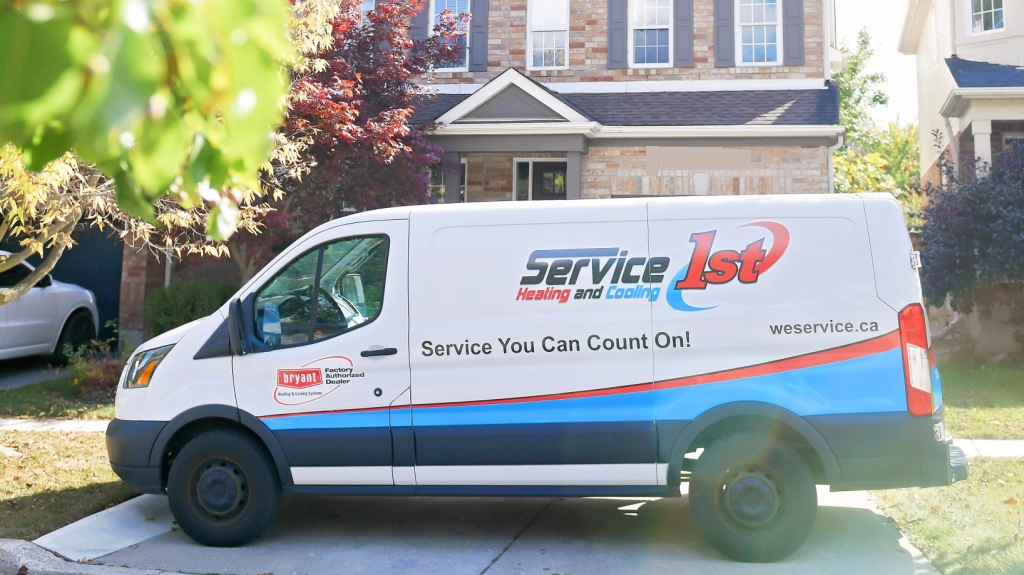
BTU Meaning: Proper HVAC maintenance is essential for keeping your system operating at its intended BTU capacity.
Without regular maintenance, your HVAC system may lose its ability to operate at its full BTU capacity. This means your furnace might struggle to keep your home warm on cold days, or your air conditioner might fail to cool effectively during a heatwave. Neglecting maintenance also increases energy usage, shortens the system lifespan, and leads to costly repairs or replacements.
Proper HVAC maintenance is essential for keeping your system operating at its intended BTU capacity. By investing in regular upkeep, you’ll enjoy consistent comfort, lower energy bills, and a longer-lasting system. Make maintenance a priority to protect your home’s comfort and your investment.
Why Choose Service 1st Heating and Air Conditioning?
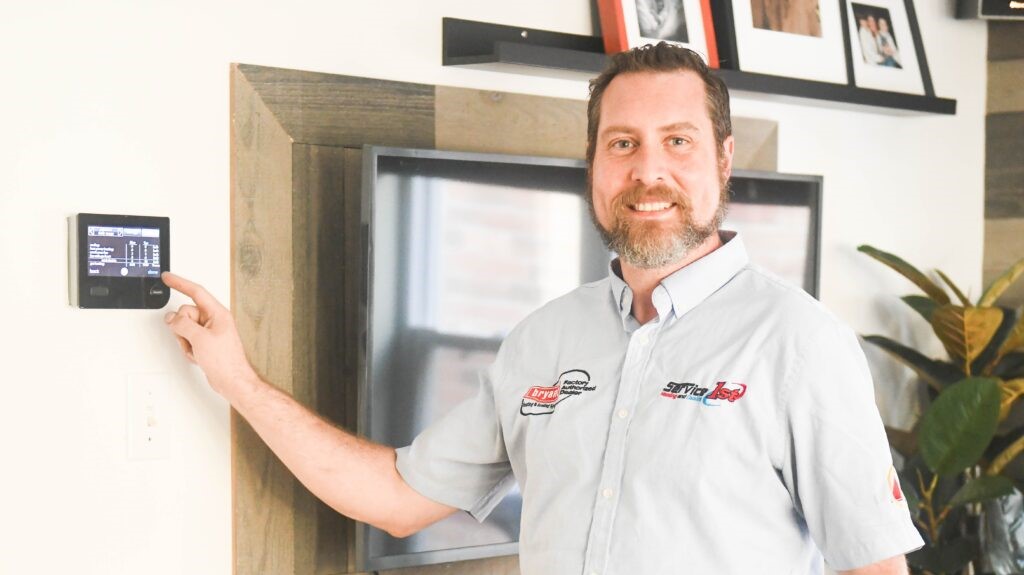
Your HVAC system is essential to creating a comfortable and efficient home environment. Understanding when to call a professional for maintenance, repairs, or replacements can save you money, reduce energy waste, and ensure your system runs smoothly for years to come.
When it comes to professional HVAC maintenance, repairs, or replacements, Service 1st Heating and Air Conditioning is the trusted choice for homeowners. Here’s why:
- Expert Diagnosis and Repairs: Our skilled technicians quickly identify and resolve HVAC issues, restoring comfort and efficiency to your home.
- Comprehensive Maintenance Plans: Regular maintenance ensures your system operates at peak performance, prolonging its lifespan and preventing costly breakdowns.
- Custom Replacement Recommendations: If your system needs upgrading, we provide tailored advice to help you choose the perfect HVAC system for your home’s size, needs, and budget.
- Energy-Efficient Solutions: We specialize in modern HVAC systems designed to save energy and reduce utility bills, including options with smart technology.
- Customer-Centric Service: We prioritize your satisfaction, offering transparent pricing, timely service, and expert guidance every step of the way.
Don’t wait until small issues become major problems. Contact Service 1st Heating and Air Conditioning for expert maintenance, repairs, and HVAC replacements tailored to your needs. Schedule your HVAC system maintenance or consultation with Service 1st today and experience the difference of working with a trusted professional team!



What Our Customers Are Saying...
“Chris was absolutely amazing!! He took the time to explain exactly what my issue was with my furnace. Very knowledgeable and very patient in his explanations. Service 1st you have a valuable team player. Will definitely recommend Service 1st to family and Friends!! I found all service technicians very informative and very professional. I had the ducts in my house cleaned, my gas fireplace tuned up and a whole new furnace and heat pump installed. I would highly recommend Service 1st!!”




